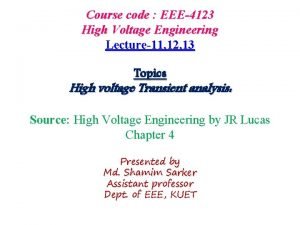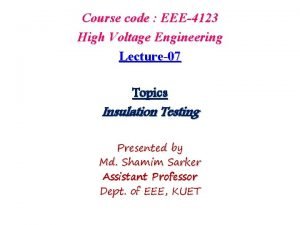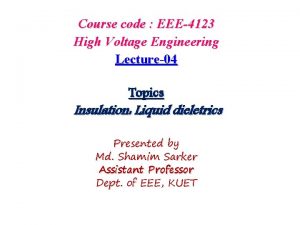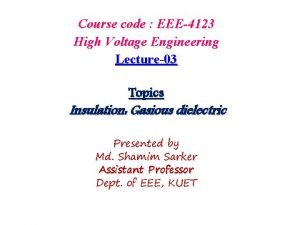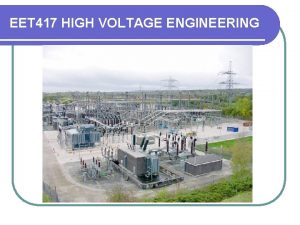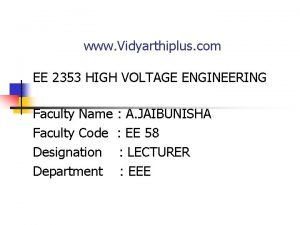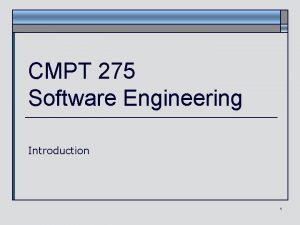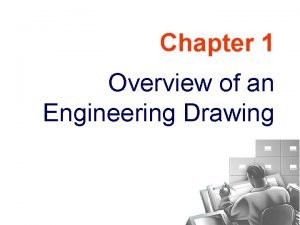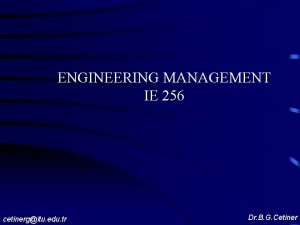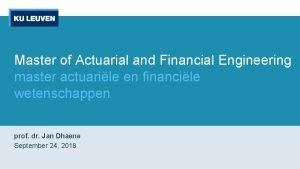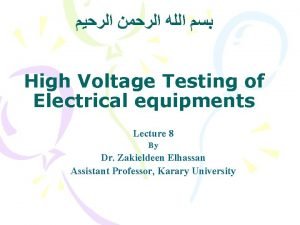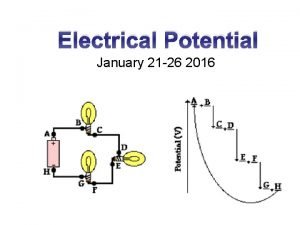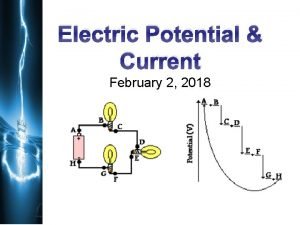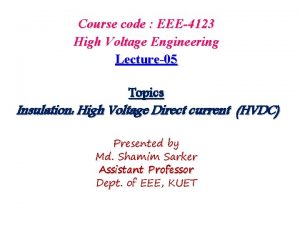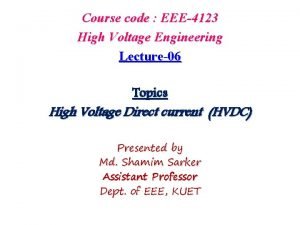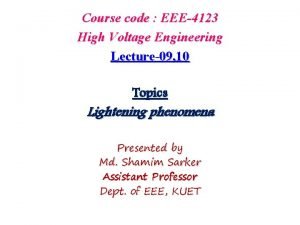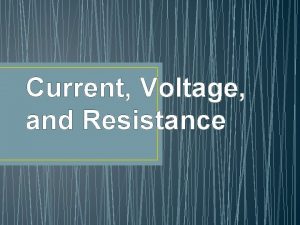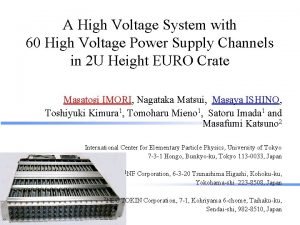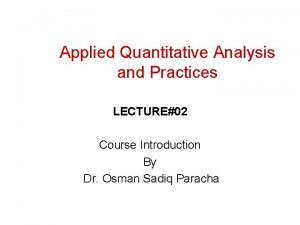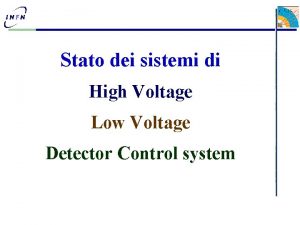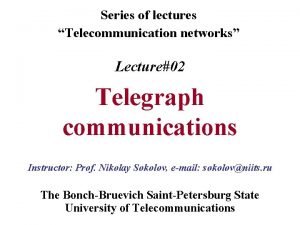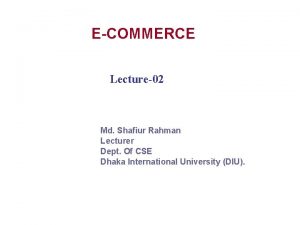Course code EEE4123 High Voltage Engineering Lecture02 Topics























- Slides: 23

Course code : EEE-4123 High Voltage Engineering Lecture-02 Topics Insulation: Gasious dielectric Presented by Md. Shamim Sarker Assistant Professor Dept. of EEE, KUET

Objectives In this course you will learn the following: Insulating materials and their necessity Necessity of studying breakdown of insulation Different ionization process Town sends breakdown process

Insulating materials An electrical insulator is a material whose internal electric charges do not flow freely, and therefore make it nearly impossible to conduct an electric current under the influence of an electric field. These materials thus offer a very high resistance to the passage of direct currents. However, they cannot withstand an infinitely high voltage. When the applied voltage across the dielectric exceeds a critical value the insulation will be damaged. The dielectrics may be gaseous, liquid or solid in form. Break down in insulating materials: Gaseous dielectrics in practice are not free of electrically charged particles, including free electrons. The electrons, which may be caused by irradiation or field emission, can lead to a breakdown process to be initiated. These free electrons, are accelerated from the cathode to the anode by the electric stress applying a force on them. They acquire a kinetic energy (½ mu 2) as they move through the field. These free electrons, moving towards the anode collide with the gas molecules present between the electrodes.

In these collisions, part of the kinetic energy of the electrons is lost and part is transmitted to the neutral molecule. If this molecule gains sufficient energy, it may ionise by collision. The newly liberated electron and the impinging electron are then accelerated in the field an electron avalanche is set up. Further increase in voltage results in additional ionising processes and breakdown occurs. In uniform fields, the ionisation present at voltages below breakdown is normally too small to affect engineering applications. In non-uniform fields, however, considerable ionisation may be present in the region of high stress, at voltages well below breakdown.

Why do we need to study the breakdown of insulating medium? With ever increasing demand of electrical energy, the power system is growing both in size and complexities. The generating capacities of power plants and transmission voltage are on the increase because of their inherent advantages. If the transmission voltage is doubled, the power transfer capability of the system becomes four times and the line losses are also relatively reduced. As a result, it becomes a stronger and economical system. A system (transmission, switchgear, etc. ) designed for 400 k. V and above using conventional insulating materials is both bulky and expensive and, therefore, newer and newer insulating materials are being investigated to bring down both the cost and space requirements.

The electrically live conductors are supported on insulating materials and sufficient air clearances are provided to avoid flashover or short circuits between the live parts of the system and the grounded structures. Sometimes, a live conductor is to be immersed in an insulating liquid to bring down the size of the container and at the same time provide sufficient insulation between the live conductor and the grounded container. In electrical engineering all the three media, viz. the gas, the liquid and the solid are being used and, therefore, we study here the mechanism of breakdown of these media.

Ionization process: Ionization is the process by which an electron is removed from an atom, leaving the atom with a net positive charge. Since an electron in the outermost orbit is subject to the least attractive force from the nucleus, it is the easiest removed by any of the collision processes. The energy required to remove an outer electron completely from its normal state in the atom to a distance well beyond the nucleus is called the first ionization potential Ionization process in gas discharge: 01. Ionization by simple collusion: When the kinetic energy of an electron (½ mu²), in collision with a neutral gas molecule exceeds the ionisation energy (Ei = e Vi) of the molecule, then ionisation can occur.

02. Excitation: In the case of simple collision, the neutral gas molecule does not always gets ionised on electron impact. In such cases, the molecule will be left in an excited state M*, with energy Ec. This excited molecule can subsequently give out a photon of frequency v with energy emitted h v. The energy is given out when the electron jumps from one orbit to the next. 03. Ionization by double electron impact: If a gas molecule is already raised to an excited state (with energy Ee) by a previous collision, then ionisation of this excited molecule can occur by a collision with a relatively slow electron.

04. Photo-ionization: A molecule in the ground state can be ionised by a photon of frequency v provided that the quantum of energy emitted hv (by an electron jumping from one orbit to another), is greater than the ionisation energy of the molecule 05. Electron attachment: If a gas molecule has unoccupied energy levels in its outermost group, then a colliding electron may take up one of these levels, converting the molecule into a negative ion M-. M + e- → M 06. Electron detachment: This occurs when a negative ion gives up its extra electron, and becomes a neutral molecule. M- → M + e-

There are two mechanism of breakdown of gases: 1. Avalance breakdown 2. Streamer breakdown Avalance or Townsend breakdown process: It is based on the generation of successive secondary avalanches to produce breakdown.

Suppose a free electron exists (caused by some external effect such as radio-activity or cosmic radiation) in a gas where an electric field exists. If the field strength is sufficiently high, then it is likely to ionize a gas molecule by simple collision resulting in 2 free electrons and a positive ion. These 2 electrons will be able to cause further ionization by collision leading in general to 4 electrons and 3 positive ions. The process is cumulative, and the number of free electrons will go on increasing as they continue to move under the action of the electric field. The swarm of electrons and positive ions produced in this way is called an electron avalanche.

on gi l re gio n ntia re one ar ne Exp Li saturation region

Mathematical Analysis When the voltage applied across a pair of electrodes is increased, the current throughout the gap increases slowly, as the electrons emitted from the cathode move through the gas with an average velocity determined by their mobility for the field strength existing for the particular value of voltage. Now let, n 0 = number of electrons/second emitted from the cathode, nx = number of electrons/second moving at a distance x from the cathode α = number of ionising collisions, on average, made by one electron per unit drift in the direction of the field. [Townsend's first ionisation coefficient] 1/ α = average distance traversed in the field direction between ionising collisions.

Consider a parallel plate capacitor having gas as insulating material and separated by a distance d. A laminar of thickness dx at a distance x from the cathode. To explain the exponential rise in current, Townsend introduced a coefficient α known as “Townsend’s first ionization coefficient” and is defined as the number of electrons produced by an electron per unit length of path in the direction of field. let, n 0 = number of electrons/second emitted from the cathode n= number of electrons/second moved through a distance x from the cathode

Mathematical Analysis When these n electron move through a distance dx, they produce another dn electrons due to collision. Therefore:

In the steady state, the number of positive ions arriving at the cathode/second must be exactly equal to the number of newly formed electrons arriving at the anode. Thus the circuit current will be given by where I 0 is the initial photo-electric current at the cathode and Is called electron avalance which represents the number of electron produced by one electron in traveling from cathod to anode

Townsends seconds ionization coefficients From previous equation Taking log on both sides, we get:

cathode n 0 = number of electrons/second emitted from the n+ = number of electrons/second released from the cathode due to positive ion bombardment n = number of electrons/second reaching the anode

Total number of electron released from the cathode is and total electron reached in anode is n. Hence number of electron released from the gas is Which is equal to the positive ion produced in the gas and will bombard on the cathode

Here comes Townsends second ionization co-efficient which is defiened as the number of electron released from the cathode per incident positive ion. Hence Substituting this value in

In terms of currents

When voltage between anode and cathode is increased, the current at the anode is given by

 Eee4123
Eee4123 Surface resistance
Surface resistance Diffuted
Diffuted Disruptive critical voltage formula
Disruptive critical voltage formula Electric field stress in high voltage engineering
Electric field stress in high voltage engineering Insulation coordination in high voltage engineering
Insulation coordination in high voltage engineering Ee2353 high voltage engineering
Ee2353 high voltage engineering Voltage classification
Voltage classification Ac voltage regulator using triac
Ac voltage regulator using triac Power formula three phase
Power formula three phase Rms to-peak
Rms to-peak Explain the objective of earthing
Explain the objective of earthing Busceral
Busceral Cs 527 uiuc
Cs 527 uiuc Software engineering important topics
Software engineering important topics Engineering drawing chapter 1
Engineering drawing chapter 1 Engineering management topics
Engineering management topics Engineering meeting topics
Engineering meeting topics Financial engineering thesis topics
Financial engineering thesis topics Software engineering course syllabus
Software engineering course syllabus High voltage testing of electrical apparatus
High voltage testing of electrical apparatus High voltage mux
High voltage mux If a battery provides a high voltage it can
If a battery provides a high voltage it can If a battery provides a high voltage, it can ____.
If a battery provides a high voltage, it can ____.
